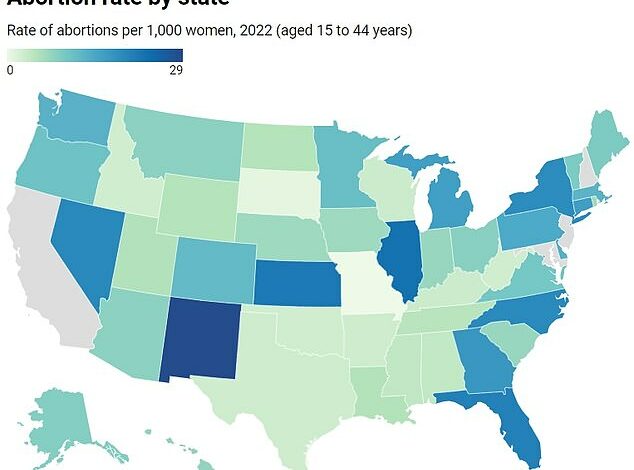Deep Red State Is America’s Surprising Abortion Hotspot, Despite Overturning Roe V Wade



Florida remained America’s abortion hotspot in the first months after Roe v Wade was overturned, new CDC data shows.
The Sunshine State recorded the most abortions in the country in 2022, with 82,581, according to the first annual report on abortions nationwide since abortion access was federally abolished in June that year.
This was almost 50 percent higher than the numbers in deep-blue Illinois, where 56,457 abortions were recorded, and New York City, where 46,373 abortions were recorded – and above similar red states like Texas, where 17,514 abortions were recorded in the same year.
Broken down by rate, which takes into account population size, New Mexico was the top state in the country, followed by Illinois and Kansas. Florida came fourth.
The report shows that the total number of abortions in 2022 fell by two percent compared to the previous year, and five percent less than almost a decade ago.
More than 92.8 percent of abortions were performed before week 13 of pregnancy and 78.6 percent before week 9. In 2022, only 1.1 percent of abortions were registered after 21 weeks of pregnancy, which amounts to a total of 4,896.
Every age group saw a decline within a year, except for women aged 30 to 34 – among whom the number of abortions rose slightly.
Doctors say that a fetus outside the womb is not viable until about 24 weeks.

The map above shows the abortion rate by state. This shows that New Mexico has the highest percentage. Based on the total number of abortions, Florida is the hot spot in the country
The CDC contacted all fifty states in the US and asked for data on the number of abortions in their area for the year 2022.
Several states did not provide data for the report, including California, the nation’s most populous state, Maryland and New Jersey.
Florida has been America’s abortion hotspot since 2020, when it overtook New York state, allowing abortions up to the 26th week of pregnancy until June 2022, when Roe v Wade was overturned by the Supreme Court.
The following month, the state passed a ban on abortions after the fifteenth week of pregnancy, and a six-week abortion ban went into effect in May 2024.
In 2022 and 2023, the 15-week limit made the state a major access point for abortions in the South — where many other states implemented stricter bans. Neighboring Alabama, for example, has banned abortions at all stages of pregnancy.
Efforts to move Florida’s ban to 24 weeks were defeated at the ballot box this month after only 57 percent of Floridians voted in favor — below the 60 percent threshold needed to pass the measure.
Donald Trump has described previously Florida’s abortion ban, which takes effect before many women realize they are pregnant, has been deemed a “terrible mistake.”
Comparing states by abortion rate, which takes into account differences in population size, New Mexico has the highest abortion rate in the country: 28.8 abortions per 1,000 women ages 15 to 44 years old.
In second place was Illinois, with 22.8 per 1,000, and Kansas was third, with 21.6 per 1,000. In terms of rate, Florida ranked fourth at 20.5 per 1,000.

The graph above shows the total number of abortions over time. They fell by two percent between 2021 and 2022
At the other end of the scale, Missouri had the lowest abortion rate of any state: 0.1 per 1,000 – or 88 abortions – in 2022.
South Dakota had the second-lowest rate, at 0.8 per 1,000, and West Virginia, Oklahoma and Idaho had the third-lowest rate, at 2.7 per 1,000.
States with the highest abortion rates also often provided abortions to out-of-state women, as well as to residents.
In New Mexico, 62 percent of abortions were performed by women who came from out of state, and in Illinois, about 30 percent of abortions were performed for this group.
New Mexico borders Texas and Oklahoma, which have some of the strictest restrictions on abortion in the country, with abortions not allowed after six weeks, including in cases of rape or incest.
Missouri was the first state to make virtually all abortions illegal in the US, after banning all but those that were medically necessary in June 2022.
This month, however, the ban was overturned at the ballot box by 52 to 48 percent, with the state now moving to allow abortions up to 24 weeks, when a fetus is viable outside the womb.
South Dakota passed a similarly restrictive abortion ban in June 2022, and a measure to overturn it was defeated this month after only 39 percent of residents voted in favor of expanding it.
Isaac Maddow-Zimet, a data scientist at the Guttmacher Institute, explained the Guardian: ‘[This data] really speaks to A [split] of access.
“On the one hand, you have a lot of states where abortion has become incredibly difficult to access – states with total bans, states with six-week bans.
“And on the other hand… we estimate that in 2023 it will be around 168,000 [women] traveled across state lines to access abortion care, which is more than double the number of people who traveled in 2019 or 2020.”
He added: “It speaks to the way that happens [women] are doing everything they can – often with strong support from many other organizations – to access abortion care when they need it.’
CDC data also showed that in 2022, the highest percentage of abortions were performed as early medical abortions before nine weeks – at more than 53.3 percent.
Surgical abortion before 13 weeks was the second most common method, at 35.5 percent, while 6.9 percent of abortions were performed surgically after 13 weeks.
Donald Trump has appointed Dr. Dave Weldon to lead the CDC, who co-authored the “Weldon Amendment,” which prohibited the Department of Health and Human Services from “discriminating against” health insurance plans that did not cover abortions.




